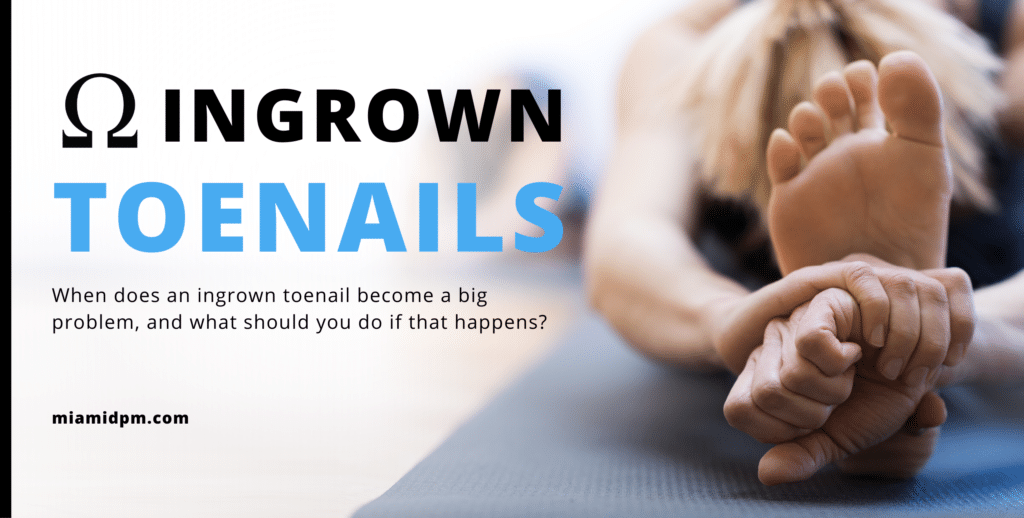What to Do When Ingrown Toenails Become a Problem
An ingrown toenail is often not something to be too concerned with. It’s often treatable well enough at home, and not much more than another item to add to the list of Life’s Minor Inconveniences.
However, not all ingrown toenails are that way. There are cases when an ingrown toenail is too much to handle with self-care, or requires the approach of a professional.
We will be describing a few cases where you may want to leave ingrown toenail treatment to us. However, we want to make sure one thing is clear before we start:
Although we are describing certain instances here, please do not take this as saying you should not contact us if you ever have any concerns that do not apply to any of these situations! Do not be hesitant to reach out to us whenever you have questions or feel you may need our help. Your health is always top priority, and that includes peace of mind as well.
With that out of the way, let’s get into some common situations when an ingrown toenail needs a podiatrist’s touch.
The Ingrown Toenail is Just Too Painful
A bit of pain should be expected with every ingrown toenail. The nail is digging into the skin beside your nail, after all!
However, if it hurts too much to even gently touch the toenail or conduct home treatment, do not feel like you need to endure all that yourself. We have the means to help relieve the pain and take care of your ingrown toenail in a way that won’t have you howling in your bathroom.
Additionally, if your ingrown toenail is in severe pain, that may be a sign of an additional problem. Speaking of which…
Your Ingrown Toenail Shows Signs of Infection
An ingrown toenail infection—as with any infections—is not something to ignore or treat lightly. Although symptoms can start off relatively minor, the problem can escalate and spread—even to the bone. At that point, it becomes a much more serious situation.
In addition to severe pain, look for other signs of infection such as:
- Redness around the nail, especially that which seems to radiate outward from the site of the injury.
- Heavy swelling.
- Throbbing.
- Bleeding.
- An overly warm or hot feeling in the area.
- Heavy discharge of pus or fluid (although a small amount of discharge can be normal in some cases).
- Pressure felt beneath the nail.
If you suspect an infection, do not wait to see if things clear up. Give us a call right away and let us know what you are experiencing.
You Have Diabetes
When you live with diabetes, every injury to the feet should be treated with some extra care. This is due to the fact that diabetes can make your feet especially vulnerable to complications and infections.
The way that diabetes can interfere with your circulation is often first felt in your feet, which already have a challenge receiving blood so far from the heart. As circulation becomes further impeded, it slows the body’s ability to heal and defend itself against invaders. This means ingrown toenails can last longer and have a higher chance of becoming infected.
This does not necessarily mean you will need to come in for an appointment every time you have an ingrown toenail, but we still want to know what’s going on. Having a record of what is happening with your feet can help us determine whether certain measures might help you better avoid such problems in the first place. The more we can prevent issues like these from happening, the lower that risk of something going wrong.
Your Ingrown Toenails Keep Coming Back
Having an ingrown toenail crop up once in a blue moon is not something to worry too much about (unless it becomes severe or infected, of course).
But if you have an ingrown toenail that just keeps happening, over and over, then that’s a big sign something is likely amiss.
Having steadily recurring ingrown toenails may mean one of a few things:
- Your shoes are placing too much pressure on your toes.
- You are not cutting your toenails properly, causing them to grow askew.
- You are applying repetitive trauma to the toenail, such as from your foot continuously sliding up against the front of your shoe while running.
- Your genetics simply make your toenails more likely to grow curved.
In the first three cases, changes in footwear and habits are often enough to put an end to the problem. However, the last cause is not something with an easy lifestyle fix.
In situations when no external factors will stop recurring ingrown toenails, we may consider the option of partially or fully removing the nail. We can then treat the underlying nailbed with a special chemical to prevent the nail from growing back. It is a simple procedure overall, able to be conducted in-office, and provides a permanent solution.
Get Help for Ingrown Toenails When You Need It!
When your ingrown toenail is mild and rare, and you feel you can treat it well enough at home with some soaking and floss, then by all means go ahead!
But if any of the above situations apply to you, or you would just rather have a professional take care of your problem for you, Omega Medical Group is here for you.
Call us at (305) 514-0404 to schedule an appointment at our offices in North Miami Beach or Miami Shores. And if you would rather reach out to us electronically, simply fill out our contact form and a member of our staff will reach out to you.


